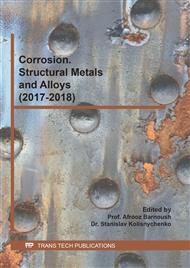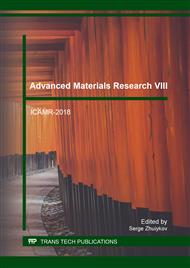p.131
p.136
p.140
p.149
p.155
p.160
p.166
p.173
p.178
Corrosion of 310S Austenitic Stainless Steel in Simulated Rocket Combustion Gas
Abstract:
High temperature corrosion of 310S austenitic stainless steel in simulated rocket combustion gas at 900 degree Celsius was investigated and discussed in this paper. 310S austenitic stainless steel was chosen because it was used for building some components of a rocket launcher. The corrosive atmosphere was prepared by mixing of hydrochloric acid and distilled water with 5.5 mole per liter then, boiling that solution and feeding into a corrosion testing chamber. The chamber was set up at 900 degree Celsius with duration 210 hrs. After testing, the corroded specimen was microscopically characterized by OM and SEM/EDS techniques. The corrosion layer was classified into three main sublayers: peeling-off scale, external corrosion sublayer, and internal corrosion sublayer. The local chemical information was analyzed by XRD (in case of peeling-off scale) and SEM/EDS (in case of external and internal corrosion sublayers). The peeling off scale mainly comprised Fe2O3 and Fe21.3O32 ferrous oxides because they needed much oxygen consumption to exist. In case of external and internal sublayers, there were a lot of pore tunnels and corrosion products. Chlorine and/or hydrogen chloride would penetrate through a passive film and, then, metal chlorides was formed on both external and internal corrosion sublayers. Metal chlorides would volatile because of their lower evaporation temperature than the testing temperature. Moreover, they were oxidized by oxygen in wet condition and resulted metal oxides mostly remaining on the external corrosion sublayer.
Info:
Periodical:
Pages:
155-159
Citation:
Online since:
March 2018
Authors:
Price:
Сopyright:
© 2018 Trans Tech Publications Ltd. All Rights Reserved
Share:
Citation:



